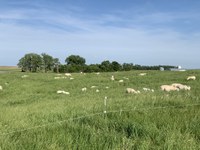Livestock Nutrient Management Important on Small Farms
(Click the image below to view a high-resolution image that can be downloaded)
Whether small farms have cattle, horses, sheep or goats, having a plan for spring grazing and manure management is important, especially during dry years, according to a North Dakota State University Extension agent and specialist.
“Monitoring grazing readiness ensures that grazing starts at the proper time,” says Penny Nester, NDSU Extension agriculture and natural resources agent in Kidder County. “Many times, we are tempted to turn animals out at the first sign of green in the pasture. Grazing too early can limit forage production for the rest of the grazing season and hurt plant health for years to come.”
She recommends that grazing readiness be based on the developmental stage of the most common or key grass species in the pasture. The recommended plant development stage to begin grazing for most tame grass pasture is at the three-leaf stage. This means that three full leaves have emerged from the main stem of the plant.
Knowing the dominant grass species in the pastures is helpful to determine which pasture to graze first in the spring. Cool-season, tame grasses typically start growing first in North Dakota and can handle heavier animal grazing earlier in the season.
Rotating animals to fresh paddocks not only allows for management of a farm’s grazing resources, but it also can help lessen nutrient overload from manure and reduce parasite pressure.
Parasites move in a continuous life cycle. Eggs are deposited in manure and through time, those eggs turn into infective larvae. The infected animals are moved to pasture, where they deposit infected manure, and the parasite is ingested and the cycle starts anew.
Parasites need cool and moist conditions to thrive. Eggs can hatch in as little as six days and larvae can last as long as 120 days. Egg development does not occur when temperatures are at or below freezing and eggs and larvae are killed when temperatures are hot and dry.
Most larvae will be found within the first 2 inches of plant growth from the base of the plant, so managing to ensure overgrazing does not occur will help decrease ingestion of parasites.
“Unfortunately, parasites can go dormant inside the host animal during unfavorable conditions, so while you may not think parasites are an issue during a drought, any change to favorable conditions can result in a rapid flush and quick development from egg to infective larvae,” warns Mary Keena, livestock environmental management specialist at NDSU’s Carrington Research Extension Center.
If rotation of animals from pasture to pasture isn’t possible, removing manure daily or weekly from the grazing area is another management strategy. Another method for breaking the parasite life cycle is to use multispecies grazing.
Parasites are host-species specific, so if an infestation occurs in sheep or goats, horses or cattle could rotate into that pasture and not be affected by those parasites. Different species also typically eat and select for different plants, which can help extend the forage supply.
For those who are experiencing small-farm challenges or would like additional tips and information, call your local county NDSU Extension agent for resources and help to keep land healthy and productive. Visit https://www.ag.ndsu.edu/extension/directory/counties for contact information on county agents.
NDSU Agriculture Communication - May 7, 2021
Source: Mary Keena, 701-652-2951, mary.keena@ndsu.edu
Source: Penny Nester, 701-475-2672, penny.nester@ndsu.edu
Editor: Ellen Crawford, 701-231-5391, ellen.crawford@ndsu.edu


